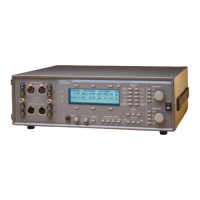GEN-TRACK mode is generally faster than AUTO-TUNE, especially
during sweeps. It can be used to tune to very low-amplitude or very
distorted signals. However, it always tunes to the current generator
frequency, so it can only be used on signals that originate from the
local analog or digital generator.
FIX-TUNE mode can be used if only a single-frequency measurement
is required. This is generally used to test single-tone quantization
distortion from a CD player, or in conjunction with optional bandpass
filters for second and third harmonic distortion measurements.
Since the analog voltmeter used to measure the amplitude before
filtering has limited dynamic range, accuracy will suffer when the dB or
% unit is used on analog signals below about 10 mV, regardless of the
notch steering mode. Since the other measurement units do not rely
on the input voltmeter, their accuracy is not compromised. The filter
tuning circuit also has hardware nulling which will slow down
dramatically for inputs below about 25 mV, regardless of the notch
steering mode. The digital analyzer does not have this limitation.
The THD+N is measured using true RMS detection except in a few of
the filtering modes described below. Several types of filters may also
be applied to the measurement.
The filter and detector combination is selected by the lower left soft
key. Three configurations are available:
.
UN-WTD – The ‘unweighted’ selection provides no filtering
except selectable bandwidth-limiting:
.
The lower center soft key selects the lower band limit (<10
Hz, 22 Hz or 400 Hz).
.
In analog mode, the lower right soft key selects the upper
band limit (>300 kHz, 22 kHz, 22 kHz-QPK, 30 kHz, 80
kHz). The 22 kHz-QPK selection uses the quasi-peak
detector instead of the true RMS detector in accordance
with CCIR-468. The 22 Hz lower limit is only available if
the upper limit is 22 kHz; the <10 Hz lower limit is only
available with other upper limits.
.
In digital mode, the lower right soft key selects the upper
band limit (15 kHz, 20 kHz, Sample Rate/2, 22 kHz, 22
kHz-QPK). The Sample Rate/2 selection always selects an
& The shapes of the
bandwidth-limiting
filters are shown on
page 6.
4 Functions
Function Descriptions THD+N (Total Harmonic Distortion plus Noise)
ATS-1 Dual Domain User's Manual 4-9

